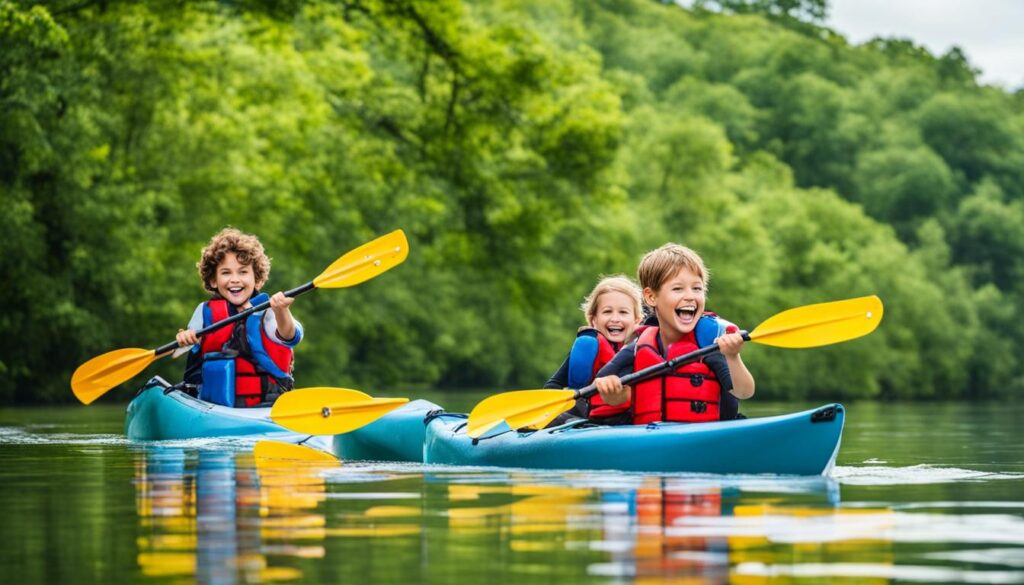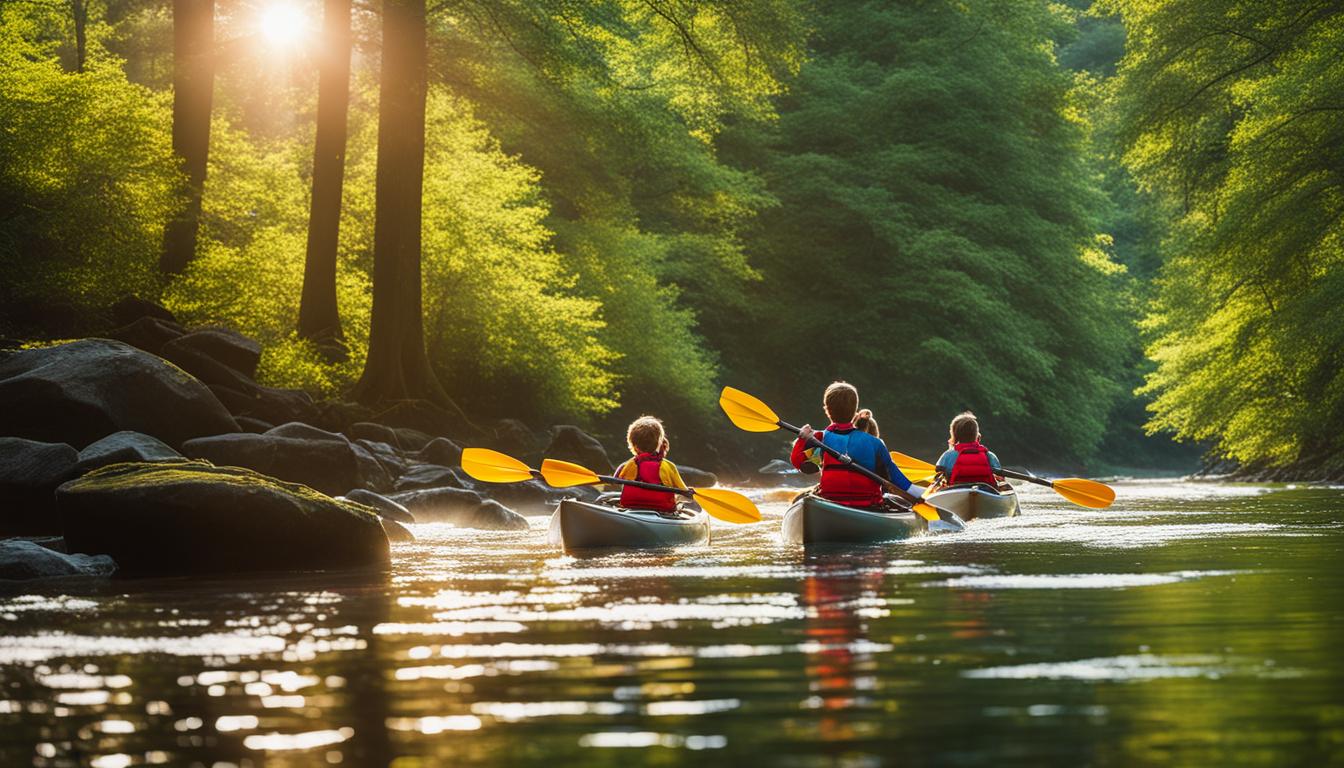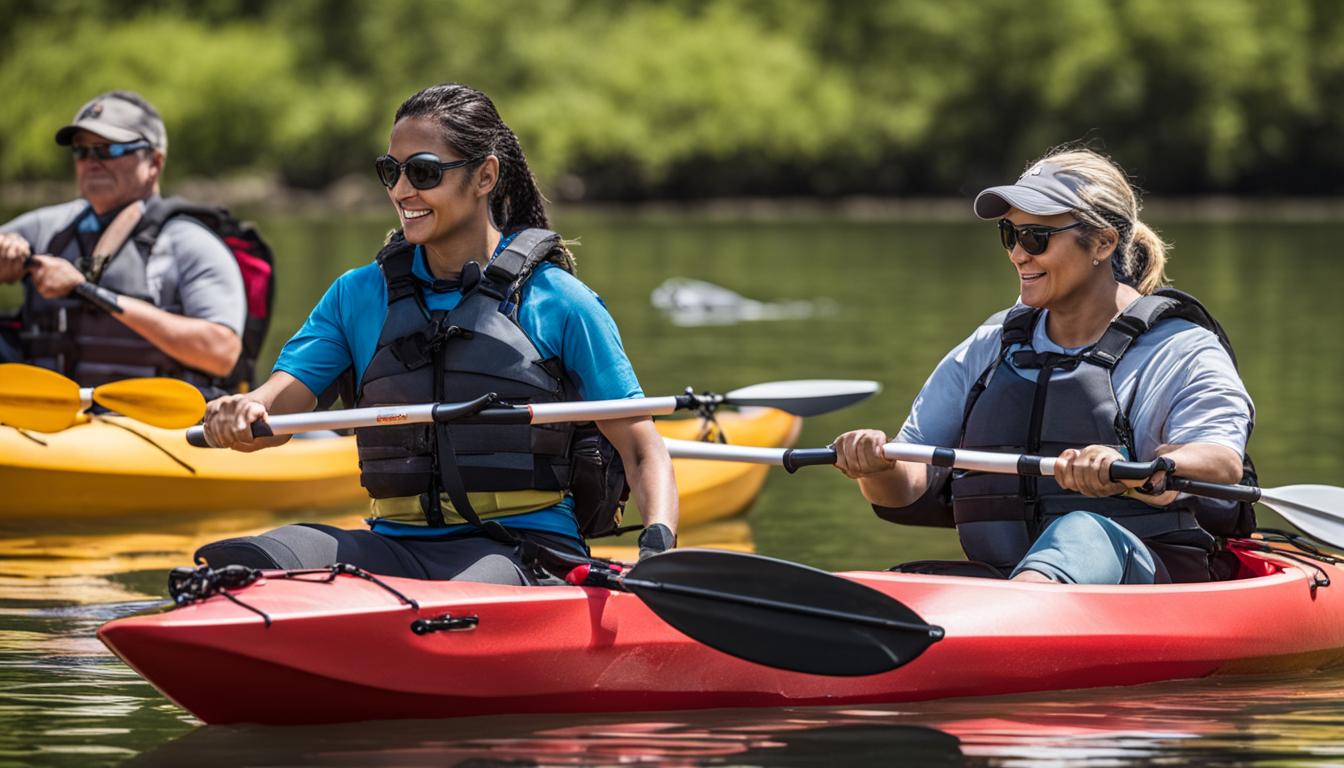Kayaking is a great activity for building confidence in kids. It offers a range of benefits, such as fostering a love for nature, teaching cooperation and determination, promoting water safety, and providing a unique vantage point for viewing wildlife. Kids can start kayaking with a grown-up as young as 2 or 3, and by the age of 7, most kids can paddle their own kayak independently.
Safety tips include wearing a personal flotation device, choosing the right location, mastering essential skills, using a smaller paddle, being aware of water and weather conditions, and maintaining a proper adult-to-child ratio.
Key Takeaways:
- Kayaking is a great way to build confidence in kids.
- It fosters a love for nature and the environment.
- Kids can start kayaking at a young age with adult supervision.
- Safety is crucial, including wearing a personal flotation device.
- Choosing the right location and maintaining proper adult-to-child ratio.
Getting Started with Kayaking for Kids
Kayaking with kids is an exciting and rewarding adventure that can create lasting memories. To get started, it’s important to generate interest in kayaking by talking to your kids about the fun and exciting experiences they can have on the water. You can even let them try sitting in a kayak to get a feel for it and spark their curiosity. If your child is old enough, enrolling them in a kayaking class or camp is a great way to introduce them to the sport and teach them the basic skills they’ll need.
When planning your kayaking trip, involve your child in the decision-making process. Choose a location that is suitable for beginners and offers interesting sights, such as calm rivers, lakes, or ponds with wildlife or natural features to explore. It’s important to select a trip that is both fun and age-appropriate for your child, ensuring they have an enjoyable experience.
Remember, the purpose of kayaking with kids is to have fun and make it an enjoyable experience for them. Encourage their sense of adventure and curiosity by pointing out interesting things along the way, such as unique plants, animals, or landmarks. Consider bringing along a waterproof camera to capture the special moments and create a visual memento of your kayaking adventure.
Making Safety a Priority
While kayaking is a fun activity, it’s essential to prioritize safety when kayaking with kids. Make sure everyone wears a properly fitted personal flotation device (PFD) at all times while on the water, regardless of their swimming ability. Choose a PFD that is approved by the U.S. Coast Guard and designed specifically for children.
Additionally, be aware of water and weather conditions before heading out on your kayaking trip. Avoid kayaking in rough waters or during inclement weather, as it can pose risks to you and your child’s safety. It’s also crucial to maintain an appropriate adult-to-child ratio to ensure constant supervision and assistance if needed.
By following these tips and guidelines, you can easily get started with kayaking for kids and create enjoyable and safe experiences for the whole family.
Benefits of Kayaking for Kids
Kayaking offers a range of benefits for kids, making it an excellent activity for them to participate in. Not only does it provide a unique vantage point for viewing nature and wildlife, but it also promotes cooperation and determination. Here are some of the key benefits:
Nature Appreciation
Kayaking allows kids to connect with nature in a special way. From their kayak, they can explore calm waters, observe wildlife up close, and experience the peace and serenity of being surrounded by nature. This fosters a love and appreciation for the environment, helping them develop an understanding of the importance of preserving our natural resources.
Unique Vantage Point
Being on a kayak provides kids with a different perspective. They can see things they wouldn’t be able to see from land, such as hidden coves, underwater creatures, and various water plants. This unique vantage point awakens their curiosity about ecology and wildlife, encouraging them to learn more about the natural world.
Cooperation and Determination
Kayaking requires teamwork and cooperation. Whether they’re in a tandem kayak with a partner or paddling in a group, kids learn how to work together to achieve a common goal. They also develop determination and perseverance as they navigate through the water, overcome challenges, and build their paddling skills.
Water Safety
Kayaking is an excellent opportunity to teach kids about water safety. They learn how to wear a personal flotation device (PFD) properly, understand the importance of staying within designated areas, and become aware of potential hazards. This helps instill a sense of responsibility and ensures their safety when they’re near or on the water.
| Benefits of Kayaking for Kids |
|---|
| Nature Appreciation |
| Unique Vantage Point |
| Cooperation and Determination |
| Water Safety |

“Being on a kayak provides kids with a different perspective.”
“Kayaking requires teamwork and cooperation.”
“Kayaking is an excellent opportunity to teach kids about water safety.”
Best Age to Start Kayaking with Kids
Choosing the right age to start kayaking with your kids is crucial for their safety and enjoyment. While there is no one-size-fits-all answer, considering factors such as maturity level, swimming skills, physical ability, and parental experience can help determine the best age to begin their kayaking journey. Starting too early may pose risks, while waiting too long may limit their exposure to this exciting activity.
To help guide you, here are some general guidelines for the best starting age:
- Around 2 to 3 years old: At this age, children can join an adult in a tandem kayak. However, it’s essential that the adult has kayaking experience and the child is comfortable sitting still and can float on their own face-up while wearing a personal flotation device.
- Around 5 years old: Kids can begin paddling in the front seat of a double kayak with an adult in the back. This allows them to start learning basic paddle strokes while still having adult supervision.
- Around 7 years old: Most children can paddle their own kid-sized kayak independently at this age. They have developed the necessary coordination, strength, and attention span to handle their own kayak, providing a sense of independence and accomplishment.
It’s important to remember that these age ranges are approximate and can vary depending on each child’s development. It’s essential to assess their individual abilities and comfort levels before allowing them to venture out on their own.
Tips for Introducing Kayaking at an Early Age
Introducing kayaking at an early age can help foster a lifelong love for this outdoor activity. Here are some tips to ensure a positive experience:
- Make it a gradual process: Start with short, supervised sessions in calm waters to build their confidence and familiarity with the kayak.
- Focus on safety: Emphasize the importance of wearing a personal flotation device and teach them basic water safety rules.
- Keep it fun: Incorporate games and activities during kayaking trips to make it enjoyable and engaging for your child.
- Encourage exploration: Use kayaking as an opportunity to explore nature and teach your child about the environment, wildlife, and conservation.
By considering your child’s readiness and following these tips, you can create a positive and memorable kayaking experience that lays the foundation for a lifelong love of the sport.
| Starting Age | Key Considerations |
|---|---|
| Around 2 to 3 years old | Child can join an adult in a tandem kayak; adult must have experience; child can sit still and float on their own face-up |
| Around 5 years old | Child can paddle in the front seat of a double kayak with adult supervision |
| Around 7 years old | Child can paddle their own kid-sized kayak independently |
Safety Tips for Kayaking with Kids
Kayaking with kids can be a fun and exciting adventure, but it’s important to prioritize safety to ensure a memorable experience. Here are some essential safety tips to keep in mind:
1. Personal Flotation Devices (PFDs)
Require all children under 13 years old to wear a U.S. Coast Guard-approved personal flotation device (PFD) while kayaking. Ensure the PFD fits properly and is adjusted snugly.
2. Choosing the Right Location
Select a kayaking location with calm waters and minimal boat traffic, especially when kayaking with kids. Ponds, small lakes, and bays are ideal options. Avoid areas with strong currents or rough waves.
3. Mastering Essential Skills
Before heading out on the water, ensure that both you and your child have mastered essential kayaking skills. This includes getting in and out of the kayak, proper paddling techniques, and knowing what to do in case of an emergency, such as capsizing.
4. Smaller Paddles
Use a smaller paddle that is appropriate for your child’s size and strength. A paddle that is too long or heavy can be challenging to maneuver and may cause unnecessary strain or fatigue.
5. Water and Weather Conditions
Stay updated on current weather and water conditions before embarking on a kayaking trip. Avoid kayaking during severe weather, high winds, thunderstorms, or other hazardous conditions. Always prioritize the safety of your child.
6. Adult-to-Child Ratio
Maintain an appropriate adult-to-child ratio while kayaking with kids. This ensures that there is enough supervision and assistance available if needed. The specific ratio may vary depending on the age and experience level of the children.
By following these safety tips, you can create a secure and enjoyable kayaking experience for both you and your child. Remember to always prioritize the well-being of your child and make safety a top priority during your kayaking adventures.
Best Places to Kayak with Kids
When it comes to kayaking with kids, choosing the right location is key. You’ll want to find places that offer calm and shallow waters, ensuring a safe and enjoyable experience for your little ones. Here are some of the best places to kayak with kids:
1. Local Ponds and Lakes
Start your kayaking adventures close to home by exploring local ponds and small lakes. These bodies of water often have calm conditions and minimal boat traffic, creating an ideal environment for kids to practice their paddling skills. Plus, they’re usually easily accessible, making it convenient for a family outing.
2. Coastal Bays and Inlets
If you’re looking to add a touch of adventure to your kayaking trip, coastal bays and inlets can provide an exciting experience for kids. These locations offer a mix of calm waters and interesting features such as islands, bridges, and diverse wildlife. Just be sure to choose areas with minimal motor boat traffic to maintain a peaceful and safe environment.
3. Slow-Flowing Rivers
Slow-flowing rivers can be another great option for kayaking with kids. These rivers often have gentle currents and a more relaxed pace, allowing youngsters to navigate their kayaks with ease. Look for sections of rivers with wide channels and minimal obstacles to ensure a smooth and enjoyable journey.
Remember, no matter where you choose to kayak with your kids, always prioritize their safety. Make sure they are wearing personal flotation devices, and keep an eye on water and weather conditions. By selecting the best places to kayak with kids, you’re setting the stage for unforgettable family adventures on the water.

Tips for Making Kayaking with Kids Fun and Engaging
When it comes to kayaking with kids, the key is to make it a fun and engaging experience for them. Here are some tips to ensure your kayaking adventures with your little ones are enjoyable and memorable:
1. Choose the right gear: Make sure your child is equipped with hats, sunglasses, and sunscreen for sun protection. Dress them in comfortable and lightweight clothing that can get wet.
2. Play games: Incorporate fun and interactive games to keep your kids entertained during the kayaking trip. You can have paddle races, play “I Spy,” or even create a scavenger hunt to make the experience more exciting.
3. Make it a family adventure: Get the whole family involved in the kayaking trip. Plan a picnic or explore the surrounding area together. This not only creates bonding opportunities but also adds an element of adventure to the experience.
4. Bring snacks and drinks: Keeping your kids energized is essential for a successful kayaking trip. Pack plenty of snacks and drinks that are easy to eat on the water. Granola bars, fruit slices, and small water bottles are great options.
5. Make it educational: Use kayaking as an opportunity to teach your children about the environment and wildlife. Point out different birds, plants, or fish you encounter along the way. This can ignite their curiosity and foster a love for nature.
6. Let kids take the lead: Allow your kids to take turns leading the way during the kayaking trip. This gives them a sense of responsibility and empowers them to make decisions. It also boosts their confidence and independence.
7. Keep it short and sweet: Especially for younger kids or beginners, it’s best to start with shorter kayaking trips. Gradually increase the duration as they become more comfortable and confident in their paddling skills.
8. Bring a camera: Capture the memorable moments of your kayaking adventure by bringing a waterproof camera. You can snap photos of the beautiful scenery, wildlife sightings, and your kids enjoying themselves on the water.
9. Emphasize safety: While having fun is a priority, safety should never be compromised. Make sure everyone wears a U.S. Coast Guard-approved personal flotation device and follows proper kayaking safety guidelines. Teach your kids about water safety and the importance of being aware of their surroundings.
By following these tips, you can ensure that kayaking with your kids is a fun, engaging, and safe experience. It’s a wonderful way to create lasting memories and instill a love for outdoor activities in your children.
Conclusion
Kayaking with kids is a fantastic way to build their confidence and create lasting memories. Not only does it foster a love for nature, but it also teaches important skills like cooperation and determination. By promoting water safety and providing a unique perspective on wildlife, kayaking offers a one-of-a-kind experience for kids of all ages.
By following safety tips and making kayaking fun and engaging, you can ensure a memorable adventure for your child. Whether they start as toddlers in a tandem kayak or paddle their own kayak as they grow older, kayaking empowers kids and enhances their self-esteem. It’s a chance to have fun, explore the great outdoors, and create a lifelong love for water sports.
So, gather your gear, choose the perfect location, and embark on a kayaking journey with your kids. Discover the beauty of calm waters, interesting wildlife, and the joy of paddling together. Start small and gradually increase the duration, allowing your child to take the lead and build their confidence. With kayaking, the possibilities are endless, and the adventures are waiting for you and your little ones.
FAQ
What age can kids start kayaking?
Kids can start kayaking with a grown-up as young as 2 or 3. By the age of 7, most kids can paddle their own kayak independently.
What safety tips should I follow when kayaking with kids?
Safety tips include wearing a personal flotation device, choosing the right location, mastering essential skills, using a smaller paddle, being aware of water and weather conditions, and maintaining a proper adult-to-child ratio.
Where are the best places to kayak with kids?
Ponds, small lakes, and bays are ideal places to start kayaking with kids. Look for locations that offer interesting things to see, such as wildlife, bridges to paddle under, or islands to explore.
How can I make kayaking with kids fun and engaging?
You can make kayaking with kids fun and engaging by choosing the right gear, incorporating fun and interactive games, making it a family adventure, bringing snacks and drinks, making it educational, letting kids take the lead, keeping the trip shorter, bringing a camera, and emphasizing safety.
What are the benefits of kayaking for kids?
Kayaking helps kids foster a love for nature, teaches cooperation and determination, promotes water safety, and provides a unique vantage point for wildlife viewing.
How can I get started with kayaking for kids?
To get started with kayaking for kids, generate interest by talking to your kids about kayaking adventures, let them try sitting in a kayak, and consider enrolling them in a kayaking class if they’re old enough. Involve your child in the planning process and choose a trip that is fun and interesting for them.
What is the best age to start kayaking with kids?
The best age to start kayaking with kids depends on factors such as the child’s maturity level, swimming skills, and physical ability, as well as the parent’s kayaking skill and experience. Kids as young as 2 or 3 can kayak with a grown-up in a tandem kayak, but this is only recommended if certain conditions are met.
What gear do I need for kayaking with kids?
It’s important to have hats, sunglasses, and sunscreen for sun protection when kayaking with kids. Additionally, make sure to have a U.S. Coast Guard-approved personal flotation device for each child.
How can I ensure the safety of my child while kayaking?
Ensuring the safety of your child while kayaking involves following safety guidelines such as wearing a personal flotation device, choosing appropriate locations, mastering essential kayaking skills, using the right-sized paddle, being aware of water and weather conditions, and maintaining an appropriate adult-to-child ratio.
What are the benefits of kayaking for kids?
Kayaking helps kids foster a love for nature, teaches cooperation and determination, promotes water safety, and provides a unique vantage point for wildlife viewing.





